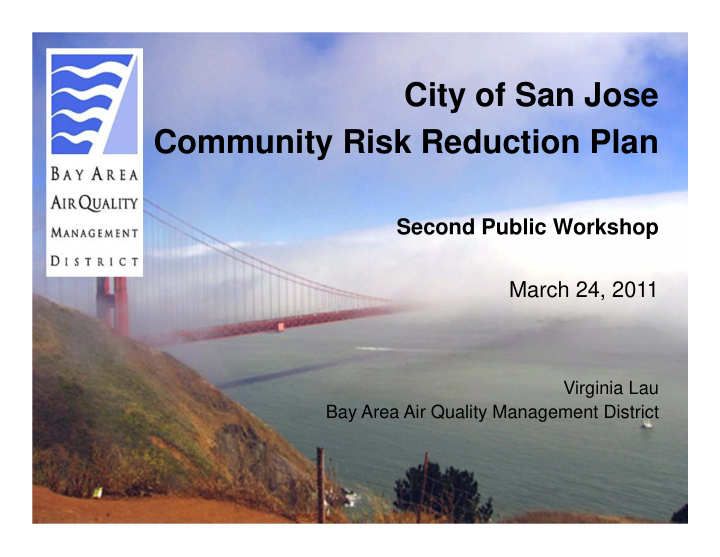



City of San Jose Community Risk Reduction Plan Second Public Workshop March 24, 2011 Virginia Lau Bay Area Air Quality Management District
Overview • Background: Community Air Risk Evaluation (CARE) for the S.F. Bay Area • Updates to Bay Area Air District’s California Environmental Quality Act (CEQA) air quality guidelines • Community Risk Reduction Plan (CRRP) 2
Community Air Risk Evaluation (CARE) Program • Evaluate regional and community cancer and non- cancer health risks from toxic air contaminants - Supplements long-standing programs to reduce regional smog (ozone, particles) • Identify sensitive populations • Focus health risk mitigation measures on locations with higher risk levels and sensitive populations 3
Emissions and Modeled Air Toxics (2005) 4 Modeled Air Toxics Risk Risk-weighted Emissions
Demographic & Income Data 5 Low Income Level Population under 18
Current Impacts and Development Areas Priority Development Areas Impacted Areas Identified
Sources and Types of Pollutants In the Bay Area By Pollutant By Source Category
Public Health Impacts of Public Health Impacts of Local Risks and Hazards Local Risks and Hazards • Health studies consistently show that living near highways has serious health consequences – Children living near a busy highway more likely to develop asthma and wheezing, suffer increased asthma attacks. – Exposure to traffic-related pollution, especially fine PM, significantly increases risk of heart attacks and premature death. – Pregnant women exposed to high levels of pollution from cars and trucks are more likely to experience problems with baby’s development, such as low birth weight. • Pre-term and early childhood exposures to carcinogens are ten times more important than previously estimated • Local land use decisions play an important role in determining exposure to air pollutants – CARB Air Quality and Land Use Handbook, 2005 – San Francisco ordinance on air quality and infill development 8
Good housing site Encourage Healthy Infill 9 Poor housing site
CEQA Updates CEQA Updates • Air District adopted updated CEQA Guidelines June 2010 • Provided risk, hazard, and PM2.5 thresholds for single source and cumulative exposures - Risk and hazards thresholds for new receptors to become effective May 2011 • Introduced Community Risk Reduction Plans (CRRPs) as option for CEQA compliance 10
Local Community Risks and Hazards Thresholds Compliance with Community Risk Reduction Plan OR • Increased cancer risk >10.0 in a million Single source • Increased non-cancer risk > 1.0 Hazard Index (Chronic (Source or or Acute) Receptor*) • Ambient PM 2.5 increase: > 0.3 µg/m 3 annual average Zone of Influence: 1,000-foot radius from proposed project Compliance with Community Risk Reduction Plan OR • Cancer: > 100 in a million (from all local sources) • Non-cancer: > 10.0 Hazard Index (from all local sources) Cumulative (Chronic) (Source or • PM 2.5 : > 0.8 µg/m 3 annual average (from all local Receptor*) sources) Zone of Influence: 1,000-foot radius from proposed project * Risk and hazards thresholds for new receptors to become effective May 2011
Community Risk Reduction Plans (CRRPs) • Supports community-wide planning approach to reduce cumulative impacts of air pollution • Promote strategies that support sustainable & livable communities – Support mixed-use, infill, transit-oriented development • Streamline CEQA review for projects consistent with plan • Invite public participation in setting goals for the community • Collaborative effort between local governments & Air District – District provides funding to cities within the impacted areas – District provides technical expertise in developing emission inventories, air dispersion modeling, and mitigation strategies • Pilot projects underway in San Jose, San Francisco 12
CRRP Elements 1. Define Planning Area 2. Develop Local-scale Emission Inventory • Permitted sources, freeways & major roadways, rail road lines, and non-permitted area sources (e.g., distribution centers, construction) 3. Develop Local-scale Risk/Hazards Modeling 4. Set Goal or Reduction Target 5. Establish Emission Reductions and Other Mitigation Measures 6. Set Monitoring and Updating Mechanism 7. Involve Public and Follow CEQA Process 13
San Jose Community Highway 880 Highway 680 LEGEND 140,000 avg vehicles per day 200,000 avg vehicles per day CARE Impacted Boundary Permitted Sources Freeways with >200,000 vehicles/day Freeways with <200,000 and >150,00 vehicles/day Freeways with <150,000 and >100,00 vehicles/day Highway 87 Freeways with <150,000 and 140,000 avg >100,00 vehicles/day vehicles per day Highway 82 60,000 avg vehicles per day Highway 280 Highway 101 14 250,000 avg vehicles Highway 17 208,000 avg per day 190,000 avg vehicles per day vehicles per day
San Jose Community LEGEND CARE Impacted Boundary Permitted Sources Freeways with >200,000 vehicles/day Freeways with <200,000 and >150,00 vehicles/day Freeways with <150,000 and >100,00 vehicles/day Freeways with <150,000 and >100,00 vehicles/day Proposed Residential/Mixed Land Use in General Plan 15
District’s Role • Develop emissions inventory and modeling parameters for: – Significant stationary sources – Mobile sources • Complete air dispersion modeling analysis • Identify areas exceeding thresholds • Collaborate with San Jose to establish policies and mitigation strategies to reduce exposures 16
Example Draft Modeling from San Francisco
Risk Reduction Strategies Risk Reduction Strategies Grant allocations to assist with mitigations & promote healthy infill Air District new or amended rules to reduce air pollution from stationary sources identified as posing health risks Indoor air quality filters and ventilation Building heights and air intakes Tree and vegetation buffers Construction equipment technologies Truck routes and idling limitations Railroad and harbor craft technologies Source specific setbacks for back-up generators, gas stations, etc. Land use and transportation planning to reduce vehicle emissions 18
Contact Information • Virginia Lau – vlau@baaqmd.gov – (415) 749-4696 • Community Air Risk Evaluation (CARE) web link: – http://www.baaqmd.gov/CARE 19
Recommend
More recommend